The nature of her homeland Iceland is the most important source of inspiration for her, a nature without trees, but with dark days in the winter and bright nights in the summer. Björk has been making music for over 30 years, and sold over 20 million records. She become the first female pop-star who had her own exhibition at MOMA in New York City. On her way there she did nothing less but revolutionizing music videos and fashion, while always pushing the conventions of the music industry. There is no genre that could ever define Björk’s work or the person Björk. She says about herself that she is one of the most idiosyncratic people around, but also “a very personal singer-songwriter, […] a scientist or explorer.”
On June 29th 2016, her five-part exhibition “Björk Digital Exhibition VR in Music – 18 Days Experiment” opened with a press event at Tokyo’s Miraikan, the National Museum of Emerging Science and Innovation. As always with Björk, the release of her album “Vulnicura”, which is by far her most personal record, was a great surprise for the music world. Never before has she opened her heart and soul to the public in such an unfiltered way. And even though it is her most exposed album yet, lyrics and music seemed not sufficient enough for making this a moment of complete intimacy. Björk designed an exhibition that utilizes Virtual Reality (VR) technology, mobile technology, and the newest cinema sound systems to allow her audience nothing less but being alone with her. And even though, with every album, every costume, and every mask we are getting to know a new, different Björk, it is all different this time. This time, it is solely her own story, without the “fairy tale bubble” she likes to mention when talking about her other songs.
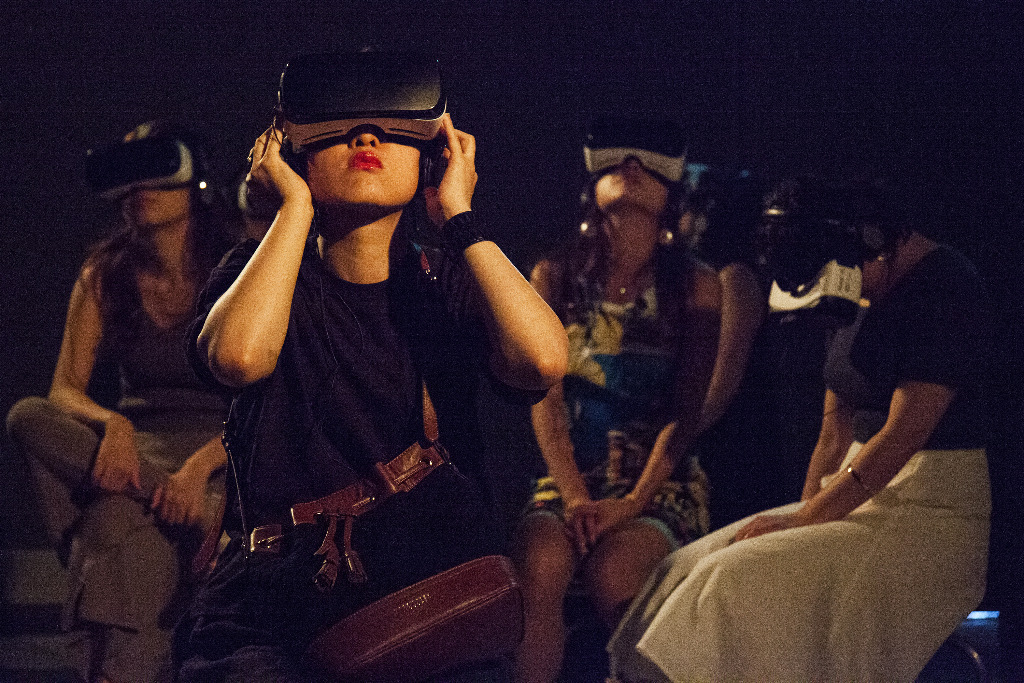
1. “I wish to synchronize our feelings”
The Icelandic artist intimate, that for decades has protected herself from the public so successfully, was one of the first to use YouTube’s VR services and uploaded a 360° video for her song “Stonemilker” from Vulnicura. After putting on the Samsung Gear VR set, and a pair of Bowers and Wilkins headphones, I find myself on a beach in Iceland. I am standing and watching Björk performing the song in a shining yellow-greenish dress. The rather sparse and grey landscape of the northern costs offers an amazing contrast to her dress and motions. With every turn I take to have a look at the environment, the sound of the song moves and stays with her on the beach. After a few looks around, I am fully immersed, and am in her world. I become more aware of the intimacy of this moment, in the rough landscape of Iceland’s coast become, when thinking about how this video was produced. Since there are no mountains, and now hiding spots for the crew on the beach, I come to realize that Björk had to be all alone with the 360° camera.
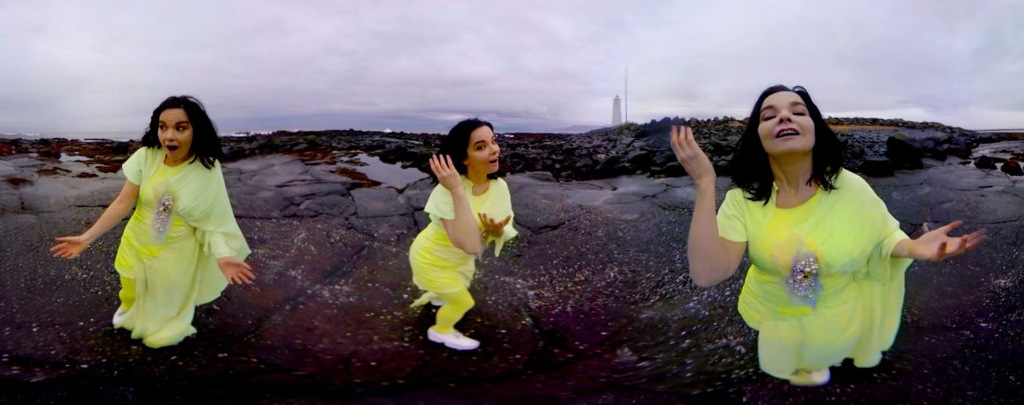
This is the moment I understand the meaning of this exhibition, and the first time VR makes me lose contact with the outside world. I am alone on the beach, with Björk, who dances around me, who walks around. And even though the lyrics are sad, and the landscape would never be printed on a postcard that shows beaches, her motion and the color of her dress, it all makes me be hopeful, even though I feel lonely.
2. “I was not heard”
After this first encounter with the performer, I am going into another room where the experience reaches a new level of intimacy. After adjusting another set of Gear VR and headphones and a short period of orienting myself in the new space, I start to understand that I am not looking at Björk anymore. There is a pink mass, darkness, and a liquid. It appears to be almost surreal, grotesque, but with the starting lyrics, I understand I am in her mouth. The mouth is on of the most vulnerable, and thus intimate spots of the human body. This VR space was created with a custom-made ball-shaped 360° camera shooting in her real mouth and high-tech models built exclusively for this experience.
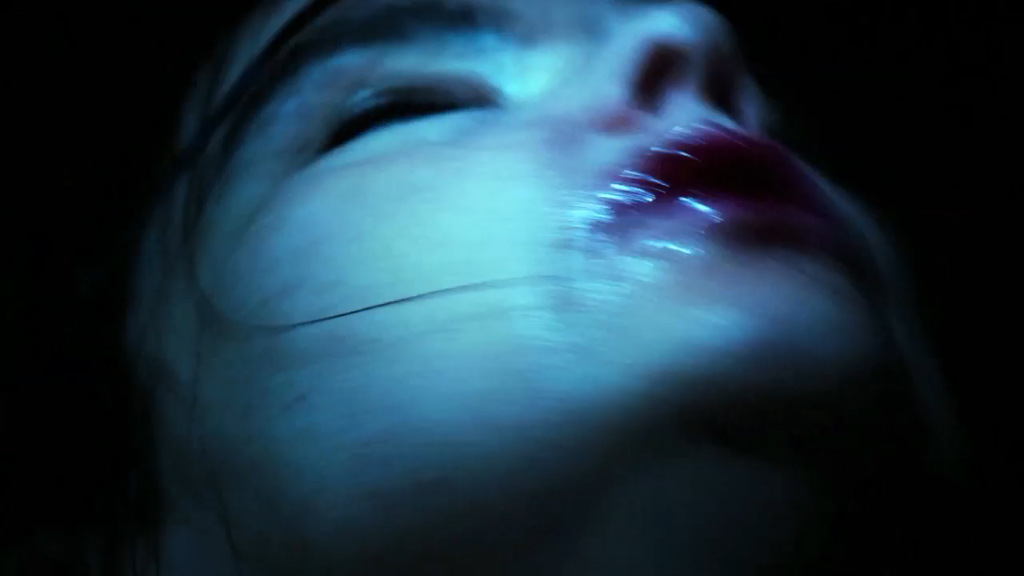
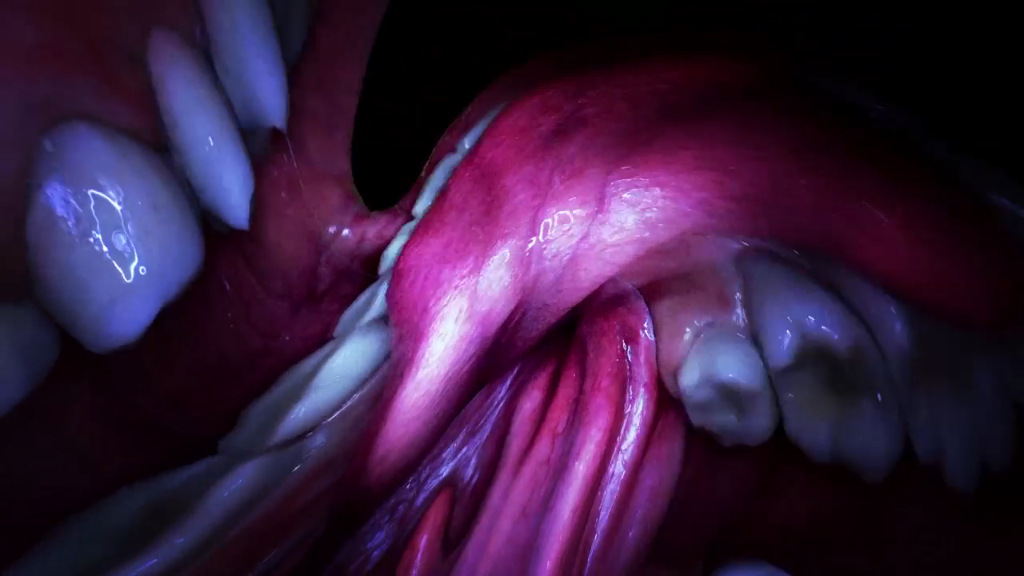
The muffled bass drum sounds of the song “Mouth Mantra” feel like her heartbeat, distant from us, but in the same universe. The universe in space, and the universe in the body are connected worlds for Björk. Towards the end of the video, I am let free from the cavern. We are moving into the outside universe, where I can see her face, and her dancing, in a blue cold light, without any background. It is a pitch black empty world, and all I see is her. While listening to the words that describe how our throat closes when we er emotionally moved, how we feel we are not heard, and how words get stuck inside, I understand that only Björk and director Jesse Kanda’s love for experimentation allow us this full VR experience. After being alone with Björk on a beach in her home Iceland, she now welcomed us inside her body. But, the person who believes that this is the final and most intimate of all possible connections is simply wrong.
3. “Your spirit entered me”
Directed by Warren du Prees and Nick Thornton Jones “Not Get” VR becomes the highest level in an evolution of degrees of intimacy. In the the third room of the exhibition the visitors are standing in booths for two people. For “Not Get VR” Björk collaborated with Intel and Rewind:VR in order to created an HTC Vive VR experience where a rendered version of Björk develops into a being of light. The higher refresh rate, better resolution (Samsung VR’s resolution is less because of the windowed view), and greater graphical power of the connected computers, allow a superb graphical experience. Together with realtime spatial audio design Rewind:VR used motion capture, a holostudio, high resolution 3D scans, and videogrammetry to develop this fully immersive and breathtaking digital form of Björk. Unfortunately, there is no way of interacting with the rendered Björk, yet. But even though producer Paul Clay thinks the current version of Not Get VR is finished, the artist herself believes that it is not yet ready.
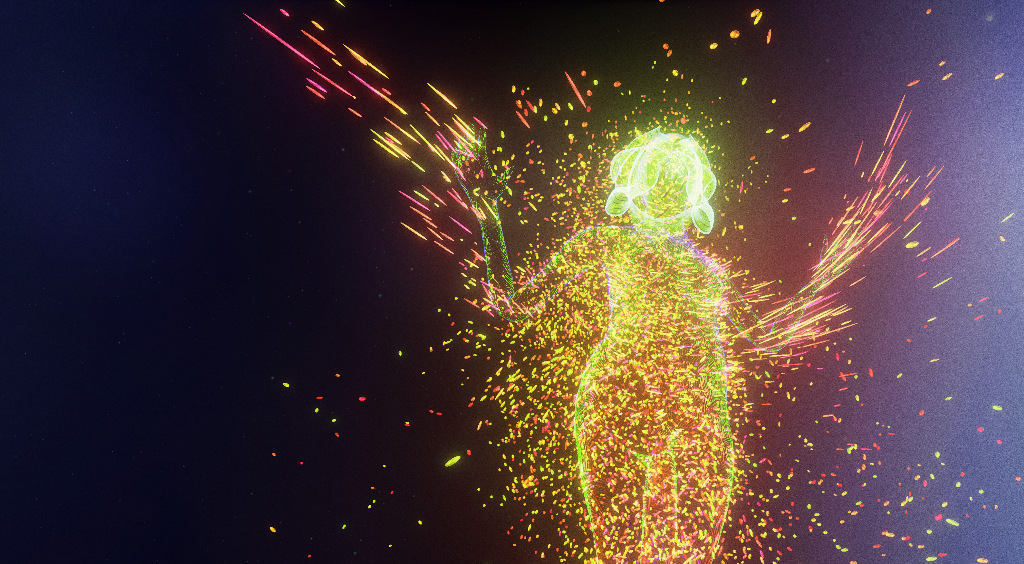
“Not Get”, which is subtitled with “11 months after” in the album booklet, describes how her wounds heal and how the spirit of the person she lost enters herself. I witnesses a personal performance by Björk in which she constantly evolves and changes her appearance. She is dancing and standing almost inside us, and it is difficult to fully grasp what is happening. I am seemingly becoming one with Björk. Colourful light particles are shining and nervously radiate through the surrounding space in red-yellow-orange colours. After all the pain and the wounds, the colours feel warm, they give me hope and a create an atmosphere of optimism.
It becomes apparent that colors play an extraordinary role in this multi-medial experience. The cover of Vulnicura shows the artist wearing a tight black dress from which blue and yellow sparks radiate. The darkness of the black, the extreme sadness and loneliness that came with the broken heart are put in contrast to the overly happy moments that happen rarely, but they happen. By going through all the pain and sadness we evolve and learn to be humble, none of us is invulnerable. Björk Digital allows us to accompany her through this experience, we are alone with her on that voyage, perfectly realized by the utilisation of VR technology in combination with her music.
4. “Initiate a touch”
After Vulnicura VR, I am going a little bit back in time. One album back, before her honest and unfiltered expression of her emotional world. At that time, Björk attempted nothing less as to combine music, nature, and technology into one piece of art. It is obvious that a single album as “Biophilia” is, can not be enough for such an endeavor. Besides a documentary, several workshops and a 2-year tour, she developed a mobile application that consist of 10 parts. Björk says that the App is very important to herself. She thinks that children are not taught music well enough and so she wants to use the combination of science and music for that purpose. In fact, Björk’s application is used in classes all over Scandinavia. For the highly ambitious software the musician developed new instruments and a new musical notation. In workshops children are taught how to compose music intuitively with the app.
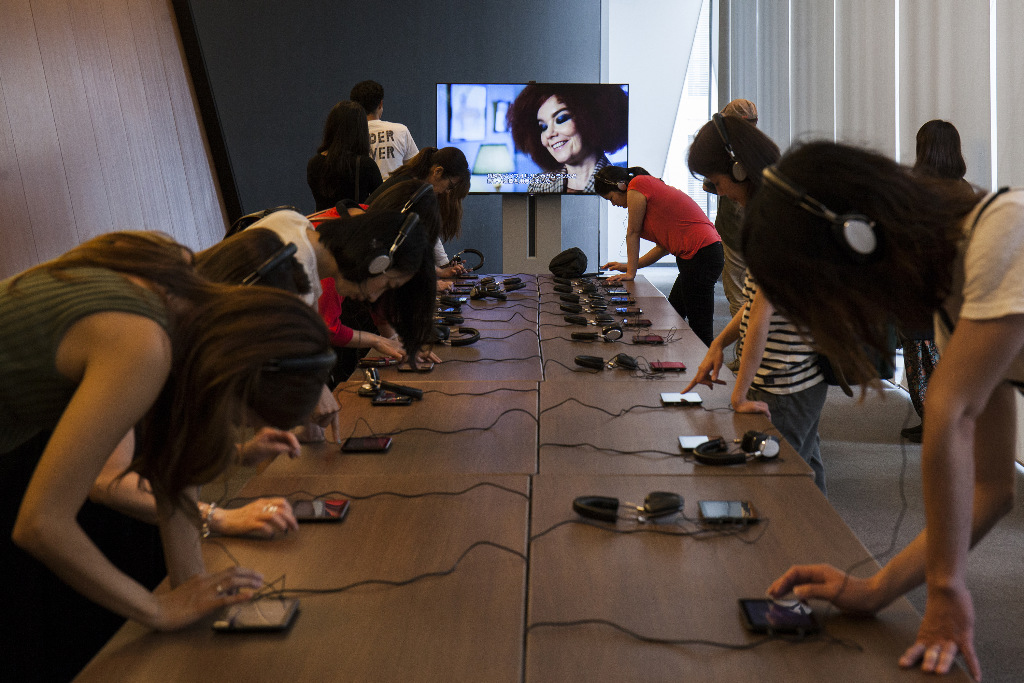
The term “Biophilia” describes a natural bond between humans and other living beings. Björk is triyng to make natural phenomena such as the growing of crystals not only audible, she wants to teach us humans nature and music. After starting the app, the user can dive into a galaxy consisting of ten stars, all named after one of the Biophilia songs. The atmospheric sounds that appear when flying through the galaxy are bits of her songs that hover by the user’s ear which contribute to a surprisingly immersive adventure. By touching on one of the stars, we are led into a smaller universe. Within these mini applications the user can now listen to the song after which the star is named, and often also contribute to it, and record a new version of it. In the mini app “VIRUS” the player watches viruses attacking body cells. With the progressing song the player can decide if the virus attack shall be stopped or can continue. If the attack is stopped the song will also come to a halt. Only by allowing the infection of the body cells to continue the player can hear the remaining parts of the song. App designer Scott Snibbe describes it as “a kind of love story between a virus and a cell. And of course the virus loves the cell so much that it destroys it.”
5. “It’s growing silently”
In the 5th, and final room of the exhibition, Björk’s motion picture legacy is concluded in a two hour curated video show. From 2D to VR, with 7.1. cinema sound, the visitor can watch her whole music video collection in an unforeseen quality. If never before, then now, It becomes clear that Björk has too many ideas to be repetitive. And even though for 30 years, every new album, every new mask, and every new costume somehow felt like she is trying to further disguise the real Björk, by just letting her work speak for itself, these two hours perfectly explain how her music and her art have transcended genre boarders ever since.
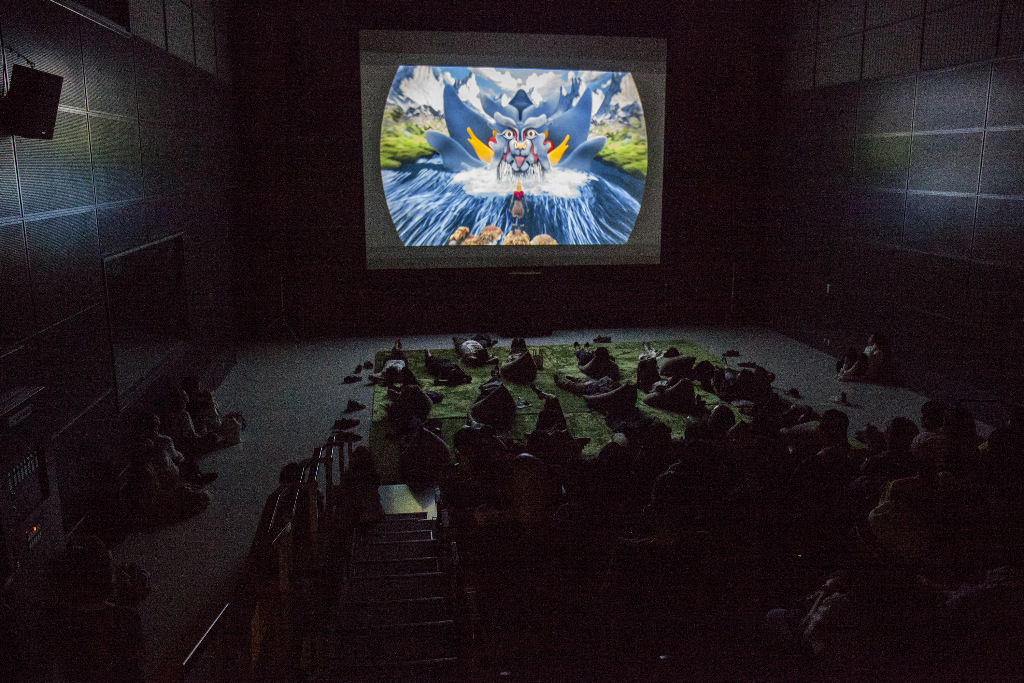
6. “What probably confuses people is they know a lot about me, but it quite pleases me that there’s more they don’t know.”
Björk has always used surreal images and lyrics to show her personalty but also that protect and disguise her privacy. With this exhibition we are allowed to be closer to Björk than ever. We can go on a journey through her emotional abyss after the most painful event in her life. She invites us to be alone with her and she sings to us and explains her pain and evolution. Through three full VR experiences we are getting closer to her and even seem to become one with Björk at one point. As Vulnicura offers us a view of the universe inside herself, the Biophilia app provides us with a view of the outside universe. In the concluding part of the exhibition we have the chance to watch all her music videos from the past up until today in a cinematic experience never seen before with 7.1 sound. And even though the music video cinema first appeared to me like a summary of an accomplished legacy, and struck me with awe, a special shooting with Björk on the 28th of June 2016 at Miraikan gave me hope that Björk will keep expanding our expectations of what a true artist can be.
